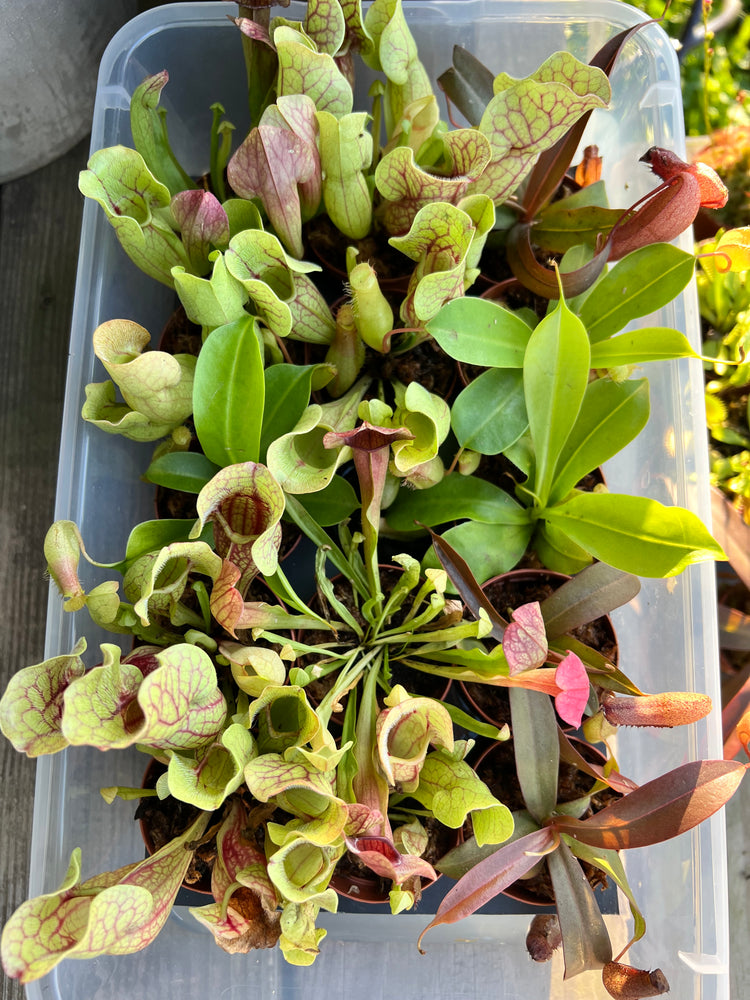Collection: Carnivorous Plants
Carnivorous plants are fascinating and unique, requiring specific care to thrive. They often grow in nutrient-poor environments, so their ability to capture and digest insects helps them survive. Here's a guide on how to care for different types of carnivorous plants, along with some helpful tips and tricks:
1. Venus Flytrap (Dionaea muscipula)
- Light: Full sunlight (at least 4-6 hours per day). They thrive on direct sunlight, so placing them on a sunny windowsill is ideal.
- Water: Use only distilled water, rainwater, or reverse osmosis water. Tap water often contains minerals that can harm them. Keep the soil moist, but don’t let it sit in water for too long.
- Soil: A mix of peat moss and perlite is ideal. They need acidic, well-draining soil with little to no nutrients.
- Feeding: They catch their own food, but if growing indoors, you may need to feed them small insects like ants, flies, or spiders (a couple of times a month). Don't overfeed; 1-2 insects per trap is enough.
- Humidity: Prefer high humidity, but they can adapt to lower humidity if the air is not too dry.
- Winter dormancy: Venus flytraps need a dormant period (usually in winter) of 3-4 months where they go into a resting state. Reduce watering and place the plant in a cooler location (around 40-50°F / 4-10°C).
Tip: Never trigger the traps by poking them; they can only close a few times before they die off.
2. Pitcher Plant (Sarracenia, Nepenthes, and others)
- Light: They require bright sunlight but can tolerate some indirect light, especially Nepenthes species, which are more tolerant of lower light conditions.
- Water: Use distilled, rainwater, or reverse osmosis water. Keep the soil consistently moist.
- Soil: For North American pitcher plants (Sarracenia), a mix of peat moss and sand works well. For tropical pitcher plants (Nepenthes), use a more airy mix with ingredients like sphagnum moss, orchid bark, and perlite.
- Feeding: They can catch their own food, but if kept indoors, you may need to feed them small insects. Make sure the insects are small enough to fit into the pitcher.
- Humidity: High humidity is necessary, particularly for tropical pitcher plants. If the air is too dry, they may not produce pitchers properly.
- Dormancy: Like the Venus flytrap, Sarracenia requires dormancy in winter (a cooler temperature with less light and reduced watering), but Nepenthes do not need dormancy and can be kept growing year-round.
Tip: Sarracenia (North American species) are outdoor plants in many regions and prefer cooler climates, while Nepenthes (tropical species) need warmer temperatures and humidity.
3. Sundew (Drosera)
- Light: They need full sunlight. A sunny windowsill or grow lights can help provide the 12-16 hours of light they need each day.
- Water: Use distilled, rainwater, or reverse osmosis water. Keep the soil moist, and avoid letting it dry out.
- Soil: Use peat moss mixed with perlite for good drainage. The soil needs to be nutrient-poor and acidic.
- Feeding: Sundews have glandular hairs on their leaves that secrete sticky droplets to catch insects. If you’re growing them indoors, you may need to feed them small insects (like gnats, fruit flies, or ants).
- Humidity: They prefer high humidity, but can tolerate lower levels with proper care.
- Dormancy: Most species of sundew go dormant in the winter. Drosera (especially temperate varieties) need cooler temperatures and less water for several months.
Tip: Avoid overfeeding. Sundews can catch enough food on their own. A single bug every couple of weeks is enough for most varieties.
4. Butterwort (Pinguicula)
- Light: They need bright indirect sunlight. Too much direct sunlight can scorch their leaves, but they still need a lot of light to stay healthy.
- Water: Use distilled, rainwater, or reverse osmosis water. Keep the soil moist, but don’t let it sit in water for too long.
- Soil: A mix of peat moss and perlite works well for most species. Some prefer a bit of sand added to the mix.
- Feeding: Butterworts have sticky leaves that catch small insects, so feeding is usually not necessary unless you’re growing them indoors. If needed, offer small insects.
- Humidity: Moderate humidity is preferred. They can tolerate a bit drier air compared to other carnivorous plants, but still, aim for at least 50-60% humidity.
- Dormancy: Some species go dormant in the winter. During dormancy, reduce watering and give the plant cooler temperatures.
Tip: Avoid feeding large insects. Butterworts have small sticky leaves, and large prey can overwhelm them or cause damage to their delicate structures.
5. Bladderwort (Utricularia)
- Light: These plants prefer bright, indirect sunlight. They can tolerate low light, but they tend to thrive with more light.
- Water: Distilled, rainwater, or reverse osmosis water is essential. They prefer constant moisture.
- Soil: Bladderworts grow in water or very wet environments. Some species grow in soil, but many species thrive in aquatic environments like ponds. Use aerated peat moss or water culture.
- Feeding: These plants catch tiny aquatic prey using small bladder-like traps. They do not need additional feeding if kept in their natural habitat, but for indoor plants, you may need to provide small aquatic animals like daphnia.
- Humidity: High humidity is ideal, but for aquatic species, they can grow directly in water.
- Dormancy: Some species may undergo dormancy in winter. Reduce watering and let the plant rest.
Tip: Keep their environment moist or submerged if they’re aquatic. Their bladders rely on water for trapping prey.
General Tips for All Carnivorous Plants:
- Watering: Always use pure water (distilled, rainwater, or reverse osmosis water) to avoid mineral buildup in the soil.
- Insect Feeding: If you're feeding your plant, never overfeed it. One or two small insects per plant per month are generally enough.
- Temperature: Keep plants within their preferred temperature range. Tropical species need warmth, while temperate species need a cold winter dormancy.
- Avoid Fertilizer: Do not fertilize carnivorous plants; they get their nutrients from insects.
- Potting: Make sure they are in pots that provide good drainage. Avoid using regular potting soil.
By following these tips for each species, you can keep your carnivorous plants healthy, happy, and thriving!


